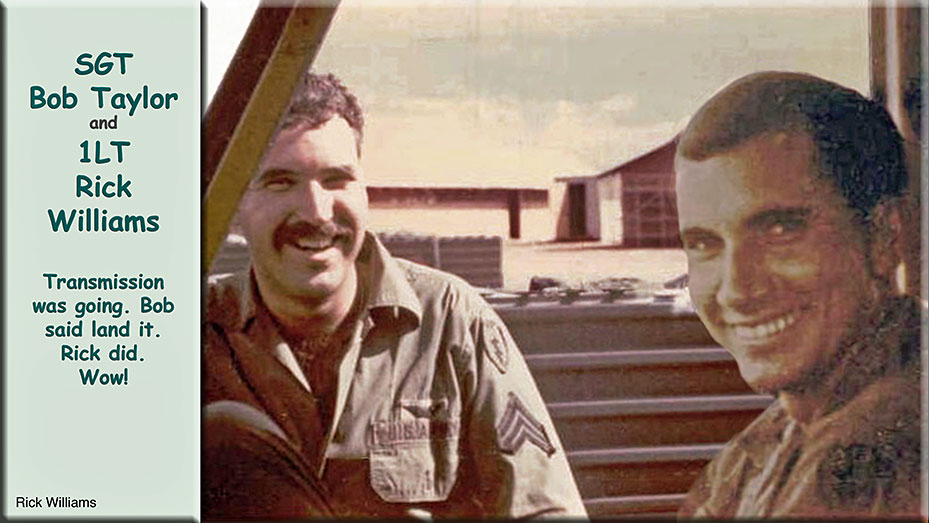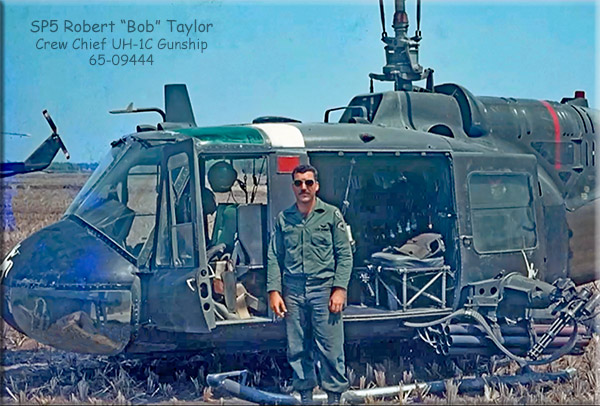

Robert "Bob" Taylor - see See UH-1C Tail Number Details &UH-1B to C Conversion
Crew Chiefs don’t know more than their pilots, just different stuff. 
It was a glorious day for flying and someone had decided we needed to take the unit’s newest pilot, Rick Williams, on a sightseeing tour of the local Cu Chi area. The gunship of choice was 444,my baby. Having responsibility for your ship is not taken lightly since four people are relying on it to get out and back safely. Today, things would not go according to plan.
We were cruising along at about 1500 feet, looking around, talking to each other, and listening to great music on Armed Forces radio when I began to realize something was not right. Flying in the same aircraft all the time is like owning an old clunker car, you get to know every squeak and rattle. You know what belongs there,  and more importantly, what doesn’t. That day, I wasn’t quite sure what I was hearing but I knew it definitely wasn’t normal. I asked everybody to be quiet while I listened. Couldn’t isolate it. I shut off all my radios. Still nothing. Then I took my helmet off, moved some smoke grenades out of the way, and put my ear up against the bulkhead. There it was. A deep grumbling I knew instantly was coming from the transmission. I got my helmet back on and screamed out “Put this SOB on the ground NOW”.
and more importantly, what doesn’t. That day, I wasn’t quite sure what I was hearing but I knew it definitely wasn’t normal. I asked everybody to be quiet while I listened. Couldn’t isolate it. I shut off all my radios. Still nothing. Then I took my helmet off, moved some smoke grenades out of the way, and put my ear up against the bulkhead. There it was. A deep grumbling I knew instantly was coming from the transmission. I got my helmet back on and screamed out “Put this SOB on the ground NOW”.
My heartfelt thanks to Lt. Williams for not taking the time to question my motives, or my sanity, he simply landed the ship and shut her down as all the caution lights started to come on.
Having spent my first tour in the 725th Maint. Btl., a field level repair unit, I was familiar with what happens when the largest gear system in the transmission, the sun gear, comes apart; it locks up and the transmission (Vis-à-vis the rotor head) stops spinning. When that happens, your rotary wing aircraft becomes a fixed wing and helicopters don’t glide well. After getting the ship sling loaded back to Cu Chi, and getting the transmission pulled apart, the Bell Helicopters tech rep told me we had about three minutes before that exact scenario would have happened. The sun gear had, in fact, begun to disintegrate.
So, in closing, your c rew chiefs may not know how to fly them but we sure know what makes them tick.
rew chiefs may not know how to fly them but we sure know what makes them tick.
Why was the UH-1B Gunship modified to be a UH -1C?
Bell commenced development of the UH-1C in 1960 in order to correct aerodynamic deficiencies of the armed UH-1B. Production began in mid 1966
Bell fitted the UH-1C with a 1,100 shp (820 kW) T53-L-11 engine to provide the power needed to lift all weapons systems in use or under development.
The Army would eventually refit all UH-1B aircraft with the same engine. (We didn't get the modifications until late 1967). A new rotor system was developed for the UH-1C to allow higher air speeds and reduce the incidence of retreating blade stall during diving engagements. The improved rotor resulted in better maneuverability and a slight speed increase. The increased power and a larger diameter rotor required Bell’s engineers to design a new tail boom for the UH-1C. The longer tail boom incorporated a wider chord vertical fin on the tail rotor pylon and larger synchronized elevators.
Bell also introduced a dual hydraulic control system for redundancy as well as an improved inlet filter system for the dusty conditions found in southeast Asia. The UH-1C fuel capacity was increased to 242 US gallons (920 liters), and gross weight was raised to 9,500 lb (4,309 kg), giving a nominal useful load of 4,673 lb (2,120 kg). UH-1C production started in June 1966 with a total of 766 aircraft produced,